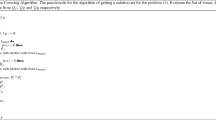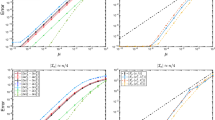Abstract
A new approach is proposed for finding allε-feasible solutions for certain classes of nonlinearly constrained systems of equations. By introducing slack variables, the initial problem is transformed into a global optimization problem (P) whose multiple global minimum solutions with a zero objective value (if any) correspond to all solutions of the initial constrained system of equalities. Allε-globally optimal points of (P) are then localized within a set of arbitrarily small disjoint rectangles. This is based on a branch and bound type global optimization algorithm which attains finiteε-convergence to each of the multiple global minima of (P) through the successive refinement of a convex relaxation of the feasible region and the subsequent solution of a series of nonlinear convex optimization problems. Based on the form of the participating functions, a number of techniques for constructing this convex relaxation are proposed. By taking advantage of the properties of products of univariate functions, customized convex lower bounding functions are introduced for a large number of expressions that are or can be transformed into products of univariate functions. Alternative convex relaxation procedures involve either the difference of two convex functions employed in αBB [23] or the exponential variable transformation based underestimators employed for generalized geometric programming problems [24]. The proposed approach is illustrated with several test problems. For some of these problems additional solutions are identified that existing methods failed to locate.
Similar content being viewed by others
References
R. Horst, P. M. Pardalos and N. V. Thoai,Introduction to Global Optimization. Kluwer Academic Publishers, 1995.
R. Horst and P. M. Pardalos.Handbook of Global Optimization. Kluwer Academic Publishers, 1995.
F. A. Al-Khayyal and J. E. Falk. Jointly constrained biconvex programming.Math. Opers. Res.,8:523, 1983.
I. P. Androulakis, C. D., Maranas, and C. A. Floudas. αBB: Global Optimization for Constrained Nonconvex Problems.J. Global Opt.,7(4), 1995 (forthcoming).
A. Brooke, D. Kendrick and A. Meeraus.GAMS: A User's Guide. Scientific Press, Palo Alto, CA., 1988.
L. G. Bullard and L. T. Biegler. Iterative Linear Programming Strategies for Constrained Simulation.Computers chem. Engng.,15(4):239, 1991.
H. S. Chen and M. A. Stadtherr. On solving large sparse nonlinear equation systems.Comp. chem. Engnr.,8:1, 1984.
D. Davidenko.Dokl. Akad. Nauk USSR,88:601, 1953.
E. Doedel.AUTO: Software for Continuation and Bifurcation Problems in Ordinary Differential Equations. Applied Mathematics, Caltech, Pasadena, CA, 1986.
I. S. Duff, J. Nocedal and J. K. Reid. The use of linear programming for the solution of sparse sets of nonlinear equations.SIAMJ. Sci. Stat. Comp.,8:99, 1987.
G. B. Ferraris and E. Tronconi. BUNSLI —a FORTRAN program for solution of systems of nonlinear algebraic equations.Computers chem. Engng,10:12, 1986.
C. B. Garcia and W. I. Zangwill.Pathways to Solutions, Fixed Points and Equilibria. Pentice Hall, 1981.
E. R. Hansen.Global Optimization Using Interval Analysis. Marcel Dekkar, New York, NY, 1992.
P. Hansen, B. Jaumard and S. H. Lu. Global optimization of univariate Lipschitz functions: I. Survey and propoerties.Math. Prog.,55:251, 1992.
R. Horst and H. Tuy.Global Optimization. Springer-Verlag, 1st. edition, 1990.
R. B. Kearfott, M. Dawande, K. Du and Ch. Hu. INTLIB, a Portable FORTRAN 77 Interval Standard Function Library,in press, 1994.
R. B. Kearfott and M. Novoa. INTBIS, a Portable Interval Newton/Bisection Package.ACM Trans. Math. Soft.,16:152, 1990.
R. W. Klopfenstein.J. Assoc. Comput. Mach.,8:366, 1961.
E. Lahaye.C.R. Acad. Sci. Paris,198:1840, 1934.
J. Leray and J. Schauder.Ann. Sci. Ecole Norm Sup.,51:45, 1934.
D. G. Luenberger.Linear and Nonlinear Programming. Addisson-Wesley, Reading, MA, 1984.
C. D. Maranas and C. A. Floudas. Global Optimization for Molecular Conformation Problems.Ann. Oper. Res.,42:85, 1993.
C. D. Maranas and C. A. Floudas. Global Minimum Potential Energy Conformations of Small Molecules.Glob. Opt.,4:135, 1994a.
C. D. Maranas and C. A. Floudas. Global Optimization in Generalized Geometric Porgramming.submitted to Comp. chem. Engnr., 1994c.
K. Meintjes and A. P. Morgan. Chemical Equilibrium Systems as Numerical Test Problmes.ACM Transactions on Mathematical Software,16(2): 143, 1990.
J. J. Moré. The Levenberg-Marquardt algorithm: implementation and theory. InNumerical Analysis-Proceedings of the Biennial Conference, Lecture Notes in Mathematics, number 630, Berlin, Germany, 1987. Springer-Verlag.
A. P. Morgan.Solving Polynomial Systems Using Continuation for Engineering and Scientific Problems. Pentice-Hall, Inc., 1987.
B. A. Murtagh and M. A. Saunders.MINOS5.0 Users Guide. Systems Optimization Laboratory, Dept. of Operations Research, Stanford University, CA., 1983. Appendix A: MINOS5.0, Technical Report SOL 83-20.
A. Neumaier.Interval Methods for Systems of Equations. Cambridge University Press, Cambridge, UK, 1990.
J. R. Paloschi and J. D. Perkins. An implementation of quasi-Newton methods for solving sets of nonlinear equations.Comp. chem. Engnr.,12:767, 1988.
M. J. D. Powell.Numerical Methods for Nonlinear Algebraic Equations. Gordon and Breach, London, UK, 1970.
H. Ratschek and J. Rokne. Experiments using interval analysis for solving a circuit design problem.J. Glob. Opt.,3:501, 1993.
G. V. Reklaitis and K. M. Ragsdell.Engineering Optimization. John Wiley & Sons, New York, NY, 1983.
L. T. Watson, S. C. Billips and A. P. Morgan.ACM Trans. Math. Soft., 13:281, 1987.
Author information
Authors and Affiliations
Rights and permissions
About this article
Cite this article
Maranas, C.D., Floudas, C.A. Finding all solutions of nonlinearly constrained systems of equations. J Glob Optim 7, 143–182 (1995). https://doi.org/10.1007/BF01097059
Received:
Accepted:
Issue Date:
DOI: https://doi.org/10.1007/BF01097059




